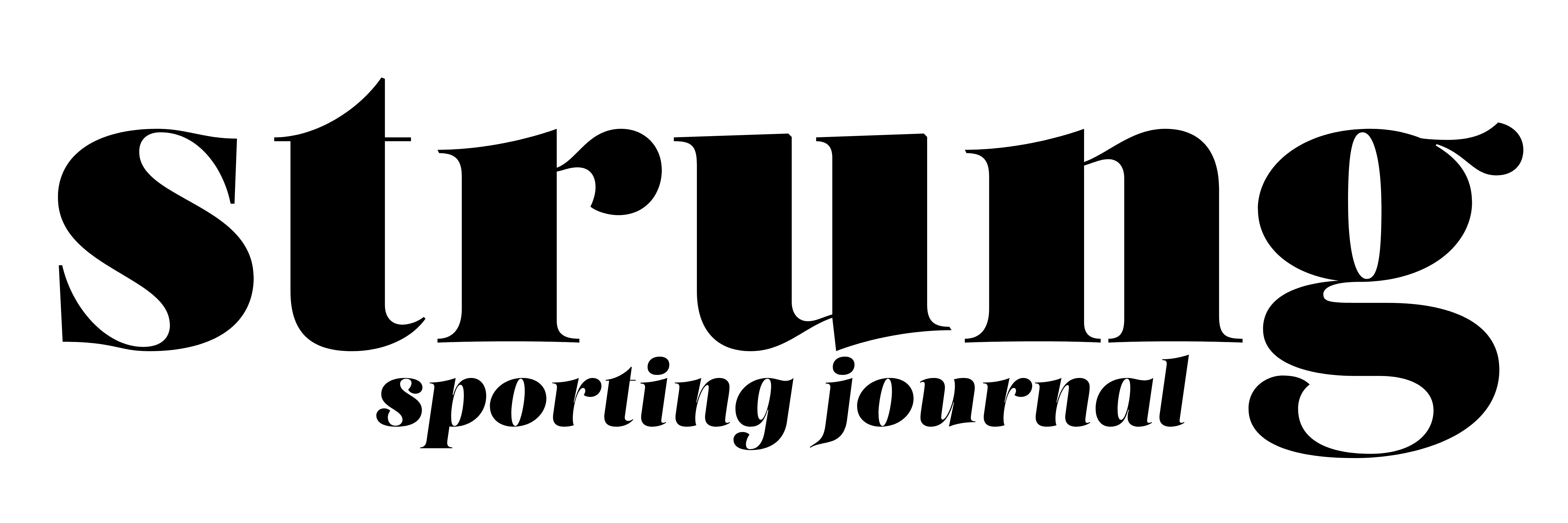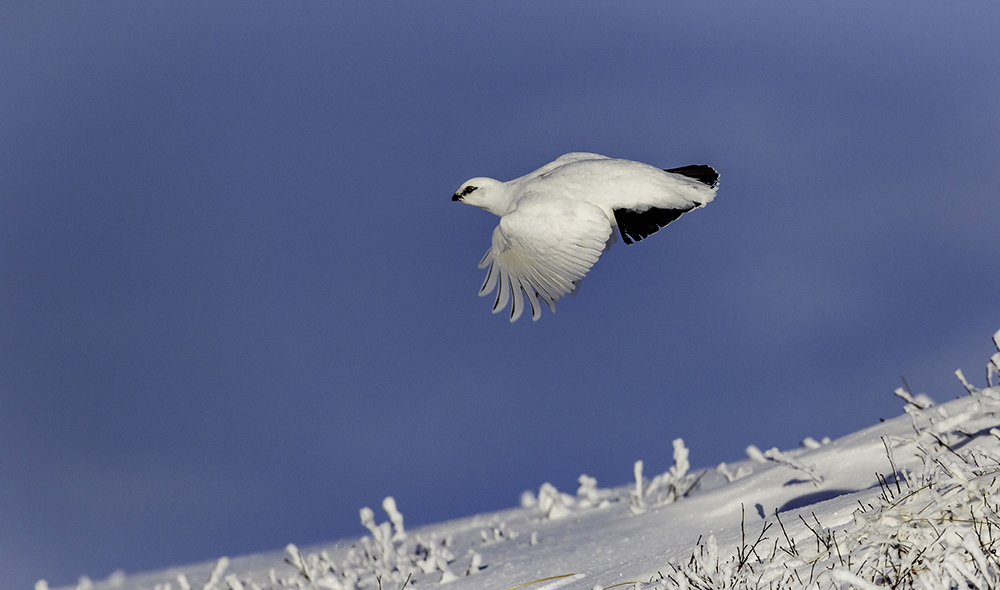Gunning the White Birds of Winter: A Day of Ptarmigan Hunting in Alaska
By Jim McCann
Cold. We know it when we feel it. But what’s cold for someone in Arizona when the temperature drops from 85 degrees to a “brutally cold” 40 degrees is a heatwave for those of us living in the heartland of Alaska. In my neck of the woods, the temperature often plummets to minus 50 degrees on winter nights. Now that’s brutally cold.
After spending way too much time indoors during the dark months of winter, I was getting anxious to return to the high country with my Brittany pointing dogs to hunt for rock ptarmigan. With a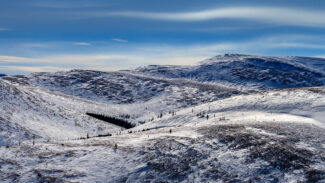 9-month long upland season in the area where I live, it’s the spring season of March and April that are, in my way of thinking, magical. While folks are raking lawns and starting gardens in the Lower 48 states, interior Alaska still looks like winter, but it’s a whole lot warmer and sunnier than a few months before. Up high above the treeline, the snow persists, and temperatures are around 10 degrees in the early morning. Still, with sunlight now lasting some eleven hours, it usually warms up to a toasty 30 degrees by mid-morning, and when you are trudging around on snowshoes, that’s plenty warm.
9-month long upland season in the area where I live, it’s the spring season of March and April that are, in my way of thinking, magical. While folks are raking lawns and starting gardens in the Lower 48 states, interior Alaska still looks like winter, but it’s a whole lot warmer and sunnier than a few months before. Up high above the treeline, the snow persists, and temperatures are around 10 degrees in the early morning. Still, with sunlight now lasting some eleven hours, it usually warms up to a toasty 30 degrees by mid-morning, and when you are trudging around on snowshoes, that’s plenty warm.
Understanding Ptarmigan Behavior
The drive through the wilderness at sunrise was peaceful, and the sighting of several moose, two small bands of caribou, a red fox, a score of snowshoe hare, and a ruffed grouse budding in an aspen tree were delightful bonuses to the day’s adventure. Arriving in the area where I planned to hunt, I tucked my truck off to the side of the road and sipped the last of my coffee as my eyes scanned the snow-covered slopes for highly camouflaged rock ptarmigan.
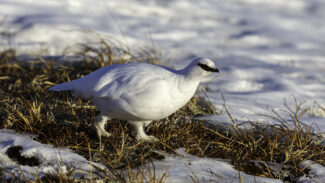 Rock ptarmigan, like any grouse, fear attack from raptors more than any other predator and will generally spend most of the day hunkered low near some form of structure. Typically, ptarmigan choose one of the scattered and grossly stunted spruce trees that dot the otherwise barren landscape. These wind-ravaged trees offer slim vertical protection from attack, but it’s better than nothing.
Rock ptarmigan, like any grouse, fear attack from raptors more than any other predator and will generally spend most of the day hunkered low near some form of structure. Typically, ptarmigan choose one of the scattered and grossly stunted spruce trees that dot the otherwise barren landscape. These wind-ravaged trees offer slim vertical protection from attack, but it’s better than nothing.
Ptarmigan are keenly aware of their highly effective winter-white camouflage and are often found in the open, but this usually occurs near a ridge of snow or a depression in the snow to hide them. These birds know to remain still, and that flushing will expose them to the keen eyes of a falcon capable of swooping in on them at speeds over 100 mph. Ptarmigan know that to fly is to die.
Starting the Ptarmigan Hunt with Skilled Pointing Dogs
After sliding out of the truck, stretching muscles, and breathing in some fresh mountain air, it was time to strap on my snowshoes and ready my hunting gear before opening dog kennels and releasing two eager Brittanys. With a simple “Hunt ‘em up!” the dogs raced up the nearby hillside and split up to hunt in opposite directions. Having two experienced dogs reaching way out beyond 200 yards, there is little chance any birds in the area will be missed. Good dogs use the wind to their advantage and, from experience, have learned to hunt the places where they have found ptarmigan before.
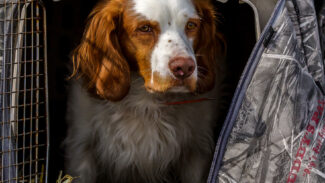 As the dogs worked left and right on their uphill drive, I moved slowly along below them, trying to warm aging muscles and catch my breath. Not far up the slope, my eye spied a small covey of around eight birds silhouetted against a vibrant blue sky. They appeared to be on the windblown snow just below the top of the ridge about a half-mile away—a welcomed sight at the start of a morning hunt. Taking mental note of their approximate position, I planned on later introducing those birds to my pointing dogs, but first, we had the slope in front of us.
As the dogs worked left and right on their uphill drive, I moved slowly along below them, trying to warm aging muscles and catch my breath. Not far up the slope, my eye spied a small covey of around eight birds silhouetted against a vibrant blue sky. They appeared to be on the windblown snow just below the top of the ridge about a half-mile away—a welcomed sight at the start of a morning hunt. Taking mental note of their approximate position, I planned on later introducing those birds to my pointing dogs, but first, we had the slope in front of us.
Young Jake is a leggy dog from field trial breeding. He covers more ground than my other dogs so it’s often Jake that finds the most birds on any given hunt. But today, Charlie carefully circled around and skillfully hunted the breeze that was blowing his direction. Several years older and a lot slower than Jake, Charlie uses his considerable experience to outshine the speedy youngster. When he circled downwind from a copse of stunted spruce, he locked up.
I quickened my pace toward Charlie, and Jake took notice and raced in our direction, eventually assuming a backing role to Charlie’s point. The sight of those two dogs standing upright and still with the long hair of their coats swaying in the breeze and their noses sucking in wild bird scent was enough to make me want to stare at them all day, but I’m a hunter, and I had serious work yet to accomplish.
Gunning the First Two Winter-White Birds
I learned a long time ago how it’s vitally important to wear snowshoes with metal cleats to safely and efficiently move over deep windblown snow. As quickly as possible, I moved within shooting range of the gnarly spruce trees where I figured the ptarmigan were likely hiding. At that point, I stopped to catch my breath before the impending shot. It was then the ptarmigan began appearing before me, a couple of them chattering and clucking as they went. Eventually, what appeared to be five ptarmigan were up and moving. I don’t particularly like downhill shots at speeding ptarmigan just a few feet off the surface of the snow, so I decided to move slowly to my right to get below them in the hope of making them flush uphill.
At a point of closeness and tolerance determined by the ptarmigan, they took flight directly uphill. Made easier by the proximity of the birds, the more pleasing angle of the shots, open chokes on my side-by-side, and a certain amount of luck, I was able to drop two winter-white birds onto the snow. I sent both dogs in for retrieves, and soon I was holding the first two birds of the hunt. Looking at the pure whiteness of these birds, it was hard to imagine just a few months earlier when they wore their brown mottled plumage, which camouflaged them just as well among the barren ground of the high Arctic. The daily limit in this area during the spring season is five birds, but if my hunt had ended right then, I would have left this wild country a happy man with two happy dogs. But we hunted on.
Finding Surprises Along the Route to the Ptarmigan Covey
At the top of the ridge, there was a significant north wind. I used the nearly bare ridge top to move quickly in the direction of where I’d seen the covey of ptarmigan earlier, but the appearance of a small clump of lichen drifting past me on top of the crusted snow in the stiff breeze piqued my interest. Something had dug under the snow and ripped lichen from the ground. This was likely the work of caribou.
A hundred yards later, my dogs stopped and stood looking at something just over the edge of the ridge and out of my sight. They lacked the staunchness of a point and briefly looked back at me as I approached them. As I crested the ridge, my suspicions were confirmed—a small group of maybe a dozen caribou briefly watched us before bolting downslope and out of sight.
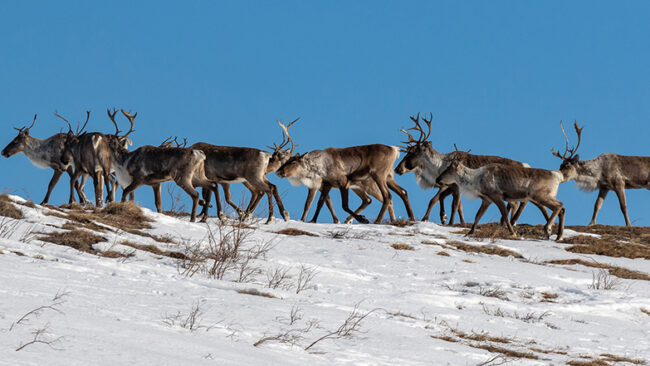 A short distance further, I sent the dogs off downhill to my right side where they’d come in downwind of where I thought the covey of ptarmigan were. As happens from time to time as the dogs loped along, two ptarmigan loafing downwind jumped from the ground and rocketed downhill. We continued down the icy slope toward where I’d seen the covey earlier.
A short distance further, I sent the dogs off downhill to my right side where they’d come in downwind of where I thought the covey of ptarmigan were. As happens from time to time as the dogs loped along, two ptarmigan loafing downwind jumped from the ground and rocketed downhill. We continued down the icy slope toward where I’d seen the covey earlier.
The dogs split up again with Charlie up high and out front of me, while Jake was down low and moving fast into the breeze. After 45 minutes of hunting and not finding any birds, I figured the covey had left the area before we could reach them. I’ve seen this happen many times over the years, but I’ve also learned it’s just as likely a hunter will miss white birds against white snow as they maneuver to avoid you.
We pushed on further up the valley, and not much later, Jake was standing point 250 yards in front of me. The going was full of pitfalls with icy waves of windblown snow combined with occasional sun-softened spots where one snowshoe would break through the snow and leave me in an awkward and physically demanding position. Wearing blaze orange, stumbling along on noisy snowshoes, and gasping for air, by the time I managed to get to Jake, the covey had grown nervous and fled their hiding place.
Preparing for the Last Good Shot
Having been on this “rodeo” so many times before, I stopped to catch my breath, let the ptarmigan settle, and plan our next move. I turned and walked directly uphill before moving parallel to where the covey watched me below. I knew they wouldn’t want to fly back toward the dogs and would likely prefer to flush downhill and stay close to the ground. Not my favorite shot, but one I’m willing to take when there is no alternative.
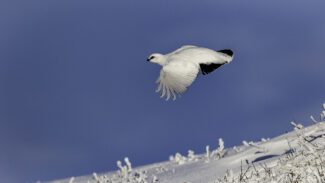 Some 25 yards uphill from the nervous birds, I picked a path downhill with my gun at the ready. About 10 yards downhill was a small, mostly bare patch of tundra where I figured I would have proper footing and take a better shot.
Some 25 yards uphill from the nervous birds, I picked a path downhill with my gun at the ready. About 10 yards downhill was a small, mostly bare patch of tundra where I figured I would have proper footing and take a better shot.
Just as I reached the bare patch of ground, a couple of ptarmigan began running before launching into flight downhill. I miffed my shot, likely shooting over the top of the bird, but when the rest of the covey flushed, I picked out the closest bird and made a proper swing-through shot. The ptarmigan rolled over in flight and fell to the ground as the others disappeared across the broad wilderness valley.
Charlie made the retrieve, and I pocketed my third ptarmigan of the morning. We circled and hunted our way back toward my truck, but I didn’t care to take any more birds. The dogs found a single ptarmigan hiding near a tiny spruce tree and pointed him nicely, but I let the bird fly off without any shooting. We were coming into the breeding season in an area I’ve been hunting for many decades. It’s my personal decision to limit my take since I hunt the same area quite often.
Ending Another Day of Ptarmigan Hunting in Alaska
Back at the truck, I checked each dog, looking for injuries before putting them back into straw-filled kennels with a treat to enjoy on the drive home. With my gear stowed, I climbed into my truck, dug out a treat for myself, and began the drive. As the heat slowly warmed the cab, I thought to myself how it had been another fabulous day of gunning the wild white birds of winter in a gorgeous wilderness. I’m fortunate to live and hunt where I do.
